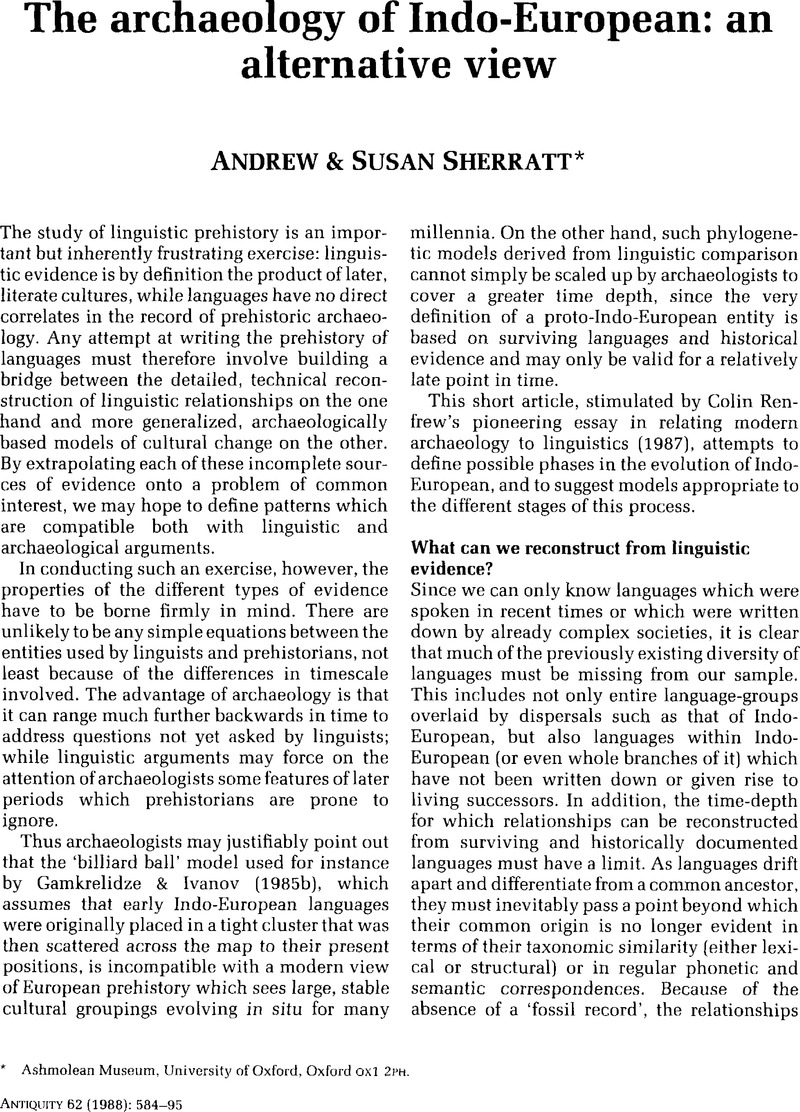Crossref Citations
This article has been cited by the following publications. This list is generated based on data provided by Crossref.
Renfrew, Colin
1989.
MODELS OF CHANGE IN LANGUAGE AND ARCHAEOLOGY.
Transactions of the Philological Society,
Vol. 87,
Issue. 2,
p.
103.
Hines, John
1991.
Reviews.
Norwegian Archaeological Review,
Vol. 24,
Issue. 1,
p.
49.
Renfrew, Colin
1991.
Before Babel: Speculations on the Origins of Linguistic Diversity.
Cambridge Archaeological Journal,
Vol. 1,
Issue. 1,
p.
3.
Robb, John
1991.
Random causes with directed effects: the Indo-European language spread and the stochastic loss of lineages.
Antiquity,
Vol. 65,
Issue. 247,
p.
287.
Barber, E.J.W.
1991.
Review of L. Markey & Greppin (1990): When Worlds Collide: The Indo-Europeans and Pre-Indo-Europeans.
Diachronica,
Vol. 8,
Issue. 1,
p.
93.
RUIZ‐GÁLVEZ, MARISA
1991.
SONGS OF A WAYFARING LAD.
Oxford Journal of Archaeology,
Vol. 10,
Issue. 3,
p.
277.
Harding, Anthony
1992.
Perspectives on Albania.
p.
14.
Robb, John
1993.
A social prehistory of European languages.
Antiquity,
Vol. 67,
Issue. 257,
p.
747.
Barbujani, Guido
Pilastro, Andrea
De Domenico, Silvia
and
Renfrew, Colin
1994.
Genetic variation in North Africa and Eurasia: Neolithic demic diffusion vs. paleolithic colonisation.
American Journal of Physical Anthropology,
Vol. 95,
Issue. 2,
p.
137.
Wilkinson, T. J.
1995.
Pavel Dolukhanov. Environment and ethnicity in the Middle East. (Worldwide Archaeology Series 7.) x + 406 pages, 123 figures. 1994. Aldershot: Avebury; ISBN 1-85628-706-8 hardback £45..
Antiquity,
Vol. 69,
Issue. 262,
p.
209.
Zvelebil, Marek
1995.
At the Interface of Archaeology, Linguistics and Genetics: Indoeuropean Dispersals and the Agricultural Transition in Europe.
Journal of European Archaeology,
Vol. 3,
Issue. 1,
p.
33.
Kitson, P.R.
1996.
BRITISH AND EUROPEAN RIVER‐NAMES.
Transactions of the Philological Society,
Vol. 94,
Issue. 2,
p.
73.
Wylie, Alison
1996.
Unification and Convergence in Archaeological Explanation: The Agricultural “Wave‐of‐Advance” and the Origins of Indo‐European Languages.
The Southern Journal of Philosophy,
Vol. 34,
Issue. S1,
p.
1.
Coningham, Robin
and
Lewer, Nick
2000.
The Vijayan colonization and the archaeology of identity in Sri Lanka.
Antiquity,
Vol. 74,
Issue. 285,
p.
707.
Bellwood, Peter
2001.
Early Agriculturalist Population Diasporas? Farming, Languages, and Genes.
Annual Review of Anthropology,
Vol. 30,
Issue. 1,
p.
181.
Zimmer, S.
2002.
Tendenzen der Indogermanischen Altertumskunde 1965–2000. I. Teil: Sachkultur.
Kratylos,
Vol. 47,
Issue. 1,
p.
1.
Zimmer, S.
2002.
Proceedings of the Tenth Annual UCLA Indo-European Conference, Los Angeles, May 21–23, 1998. Ed. by K. JONES-BLEY, M. HULD, A. DELLA VOLPE, and M. ROBBINS DEXTER.
Kratylos,
Vol. 47,
Issue. 1,
p.
58.
Diamond, Jared
and
Bellwood, Peter
2003.
Farmers and Their Languages: The First Expansions.
Science,
Vol. 300,
Issue. 5619,
p.
597.
Richards, Martin
2003.
The Neolithic Invasion of Europe.
Annual Review of Anthropology,
Vol. 32,
Issue. 1,
p.
135.
Kristiansen, Kristian
2005.
What language did Neolithic pots speak? Colin Renfrew’s European farming-language-dispersal model challenged.
Antiquity,
Vol. 79,
Issue. 305,
p.
679.



